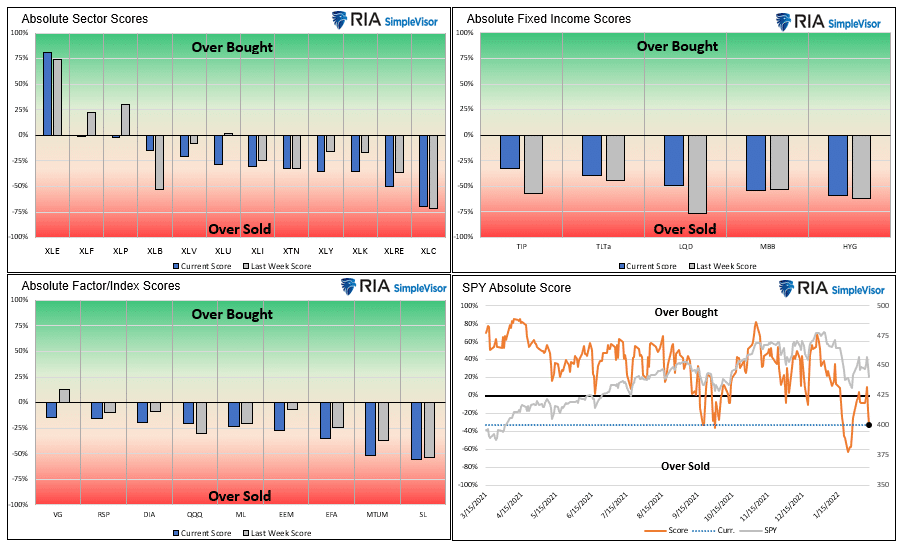The scorecard report uses a series of technical studies to quantify how various sectors, factors, and indexes score on a technical basis versus the S&P 500 (relative value) or versus a more appropriate benchmark, as well as on an absolute stand alone basis (absolute value).
Relative Value Graphs
- Energy continues to be a leading sector gaining another 2.5% versus the S&P 500 this past week. Also, small and mid-cap stocks did well versus the S&P 500. Might they be starting to rebound versus the market, or is this a short-term relative bounce? Believe it or not, over the last 35 trading days, small caps have edged out the S&P 500 and NASDAQ.
- Energy and Financials are the most overbought sectors while Communications continues to languish. Facebook, representing nearly a quarter of the Communications sector, was down almost 8% last week, following its 25% decline on earnings in the week prior.
- Note the nice improvement in the Materials and Transportation sectors over the past week. Both sectors beat the S&P 500 by about 3% last week.
- On the fixed income graph, upper right, inflation is doing well versus nominal UST notes. Interestingly, inflation expectations have been stable at 2.80-2.85%. TIPS rose slightly in price last week while most other bond funds fell. The 7.5% surprise inflation is undoubtedly one factor behind its slight outperformance.
Absolute Value Graphs
- On an absolute basis, the standout sector is Energy. Its score continues to stick at 75% and higher. The sector is grossly overbought using this methodology and many other technical studies. While it remains overbought on a short-term basis, it has grossly underperformed on a longer-term scale. Over the last five years, the S&P 500 has been up almost 90%, while the energy sector has slightly declined. Now consider these numbers and reflect that Energy beat the S&P 500 by about 40% over the last year. A good case can be made to own energy stocks on a longer-term basis, but we continue to warn they are at risk in the short term for a decline. The third graph below shows the recent solid relative performance but the poor decade-long relative performance versus the S&P 500.
- The equity sell-off late last week pushed the S&P 500 to moderately oversold levels. Other technical gauges we follow are just turning onto sell signals. Markets may be headed for a retest of the late January lows.
- Excluding Energy, all sectors and factors/indexes are oversold. Communications, however, is the only sector approaching levels that argue a bottom is nearby.
- The fixed income sectors are all decently oversold. Fixed income tends to be less volatile than equities. As such, we consider a score of +/- 50% as grossly overbought or oversold. Investment-grade corporates (LQD), Mortgages (MBB), and Junk (HYG) now have scores below -50%. TLT and TIPs are trading slightly better as investors have been rotating towards the safety of government bonds. Such results in spread widening for credit products.



Users Guide
The technical value scorecard report is one of many tools we use to manage our portfolios. This report may send a strong buy or sell signal, but we may not take action if other research and models do not affirm it.
The score is a percentage of the maximum score based on a series of weighted technical indicators for the last 200 trading days. Assets with scores over or under +/-70% are likely to either consolidate or change the trend. When the scatter plot in the sector graphs has an R-squared greater than .60, the signals are more reliable.
The first set of four graphs below are relative value-based, meaning the technical analysis is based on the ratio of the asset to its benchmark. The second set of graphs is computed solely on the price of the asset. At times we present “Sector spaghetti graphs,” which compare momentum and our score over time to provide further current and historical indications of strength or weakness. The square at the end of each squiggle is the current reading. The top right corner is the most bullish, while the bottom left corner is the most bearish.
The ETFs used in the model are as follows:
- Staples XLP
- Utilities XLU
- Health Care XLV
- Real Estate XLRE
- Materials XLB
- Industrials XLI
- Communications XLC
- Banking XLF
- Transportation XTN
- Energy XLE
- Discretionary XLY
- S&P 500 SPY
- Value IVE
- Growth IVW
- Small Cap SLY
- Mid Cap MDY
- Momentum MTUM
- Equal Weighted S&P 500 RSP
- NASDAQ QQQ
- Dow Jones DIA
- Emerg. Markets EEM
- Foreign Markets EFA
- IG Corp Bonds LQD
- High Yield Bonds HYG
- Long Tsy Bonds TLT
- Med Term Tsy IEI
- Mortgages MBB
- Inflation TIP
- Inflation Index- XLB, XLE, XLF, and Value (IVE)
- Deflation Index- XLP, XLU, XLK, and Growth (IWE)

Michael Lebowitz, CFA is an Investment Analyst and Portfolio Manager for RIA Advisors. specializing in macroeconomic research, valuations, asset allocation, and risk management. RIA Contributing Editor and Research Director. CFA is an Investment Analyst and Portfolio Manager; Co-founder of 720 Global Research.
Follow Michael on Twitter or go to 720global.com for more research and analysis.
Customer Relationship Summary (Form CRS)
Also Read


















